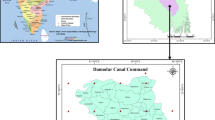Abstract
Evapotranspiration (ET) is one of the largest components of hydrological cycle, and its accurate quantification is needed in water allocation, irrigation management, and to protect surface and ground water quantity and quality. So there is a need of improved techniques for accurate quantification of ET to enhance efficient use of water resources and sustainability of agro-ecosystem productive. A number of methods have been developed till now for ETo estimation, but most of them are only applicable in areas where they have been developed. Till now, only the Penman method has been accepted worldwide which is acceptable in almost all climatic conditions, but the only major drawback of this method is the large number of data requirement. Therefore, in this study, we have used four reference ETo estimation methods which include two radiation methods (Turc and Priestley–Taylor), one temperature (Hargreaves), and one combined method (Penman method) of ETo estimation. The weekly average meteorological data for the period 1975–2005 were used here to estimate ETo. This study has attempted to select reliable reference ET estimation method other than Penman where less input variables are required. Here, Penman-derived ETo has been selected as the standard for evaluating the performance of other methods of ETo estimation. This study has further attempted to demonstrate some of the significant applications of estimated ETo. The execution of all radiation- and temperature-based methods shows that outcome of Turc-derived ETo is comparable with Penman-derived ETo, and thus this can be used for ETo estimation for this region other than Penman method.



Similar content being viewed by others
References
Allen RG, Pereira LS, Raes D, Smith M (1998) Crop evapotranspiration-guidelines for computing crop water requirements-FAO Irrigation and drainage paper 56, vol 300. FAO, Rome, p 6541
Brutsaert W (2005) Hydrology: an introduction. Cambridge University Press, Cambridge
Cai J, Liu Y, Lei T, Pereira LS (2007) Estimating reference evapotranspiration with the FAO Penman–Monteith equation using daily weather forecast messages. Agric For Meteorol 145:22–35
Chattopadhyay N, Hulme M (1997) Evaporation and potential evapotranspiration in India under conditions of recent and future climate change. Agric For Meteorol 87(1):55–73
Chen D et al (2005) Comparison of the Thornthwaite method and pan data with the standard Penman–Monteith estimates of reference evapotranspiration in China. Clim Res 28(2):123–132
Chen J-F, Yeh HF, Lee CH, Lo WC (2005) Optimal comparison of empirical equations for estimating potential evapotranspiration in Taiwan. In: Proceedings XXXI IAHR congress, Seoul, Korea, 11–16 September, pp. 3687–3697
Chowdhury. S, et.al, Evaluation of different methods for evapotranspiration estimation using Automatic Weather Station data estimation, Department Of Agril. Meteorology & Physics Department, Bidhan Chandra Krishi Viswavidyalaya
Jabloun MD, Sahli A (2008) Evaluation of FAO-56 methodology for estimating reference evapotranspiration using limited climatic data: application to Tunisia. Agric Water Manag 95(6):707–715
Jhajharia D, DebBarma S, Agrawal G (2004a) Comparison of pan evaporation-based reference evapotranspiration model with Penman Monteith FAO-56 model. J Agric Eng 41(3):46–52
Jhajharia D, DebBarma S, Agrawal G (2004b) Comparison of simpler radiation-based ET models with Penman Monteith model for humid region. J Agric Eng 41(4):32–36
Maeda EE, Wiberg DA, Pellikka PKE (2011) Estimating reference evapotranspiration using remote sensing and empirical models in a region with limited ground data availability in Kenya. Appl Geogr 31(1):251–258
Monteith JL (1965) Evaporation and environment. Proc Symp Soc Exp Biol 19:205–234
Penman HL (1948) Natural evaporation from open water, baresoil and grass. Proc R Soc Lond 193:120–145
Priestley CHB, Taylor RJ (1972) On the assessment of surface heat flux and evaporation using large-scale parameters. Mon Weather Rev 100(2):81–92
Senay GB et al (2011) Estimating basin scale evapotranspiration (ET) by water balance and remote sensing methods. Hydrol Process 25(26):4037–4049
Steiner JL, Howell TA, Schneider AD (1991) Lysimetric evaluation of daily potential evapotranspiration models for grain sorghum. Agron J 83(1):240–247
Wang L, D’Odorico P, Evans JP, Eldridge DJ, McCabe MF, Caylor KK, King EG (2012) Dry land eco-hydrology and climate change: critical issues and technical advances. Hydrol Earth Syst Sci 16(8):2585–2603
Acknowledgments
The authors are thankful for the technical, financial and infrastructural support received from the Centre of Excellence in Climatology (CEC), Department of Physics, BIT Mesra, Ranchi. First author is further thankful to BIT Mesra for Institute Research Fellowship.
Author information
Authors and Affiliations
Corresponding author
Rights and permissions
About this article
Cite this article
Shweta, Krishna, A.P. Selection of the Best Method of ETo Estimation Other Than Penman–Monteith and Their Application for the Humid Subtropical Region. Agric Res 4, 215–219 (2015). https://doi.org/10.1007/s40003-015-0153-y
Received:
Accepted:
Published:
Issue Date:
DOI: https://doi.org/10.1007/s40003-015-0153-y




